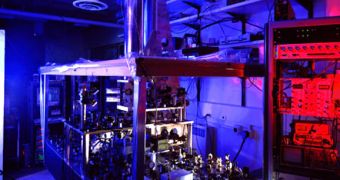Atomic clocks, also referred to as cesium fountains, are the norm when it comes to keeping time. Their measurements dictate systems such as GPSs, as well as the yearly division of days, months and so on. They are extremely suited for this kind of applications, as they basically dictate the length of a second, the basic unit of measuring time. Until now, the Coordinated Universal Time (UTC) was also controlled by three PTB-built, extremely sensitive atomic clocks. Now, a new one has managed to enter the elite club.
There are very few cesium fountains in the world, and the Germany-based Physikalisch-Technische Bundesanstalt (PTB) has managed to get four of its machines inside the elite group of those used to dictate time. The UTC reference frame is used in navigation, astronomy, telecommunications, geodesy and physical fundamental research, among other things. In all of these domains, timing is everything. In physics and chemistry, more than in other fields, knowing how to divide this construct is essential. Pulse lasers, for example, work at the femtosecond scale. A femtosecond is equal to one billionth of one millionth of a full second.
The new cesium fountain clock, CSF2, has just recently been accepted into the UTC club. Experts at the PTB say that its measurements will start being taken into account as early as this month, which is a reason for excitement at the research institute. The time standard is controlled by an institution called the International Bureau for Weights and Measures (BIPM, for Bureau International des Poids et Mesures), through its “Time, Frequency and Gravimetry” Department. There are 60 time-keeping institutes worldwide, and they possess a combined number of 300 clocks. Each of these devices produces measurements that are taken into account when setting the international standard.
However, the primary circle of cesium fountain clocks that controls time only features 12 instruments. A number of seven institutes control these instruments, and, until this month, the PTB had three under its direct supervision. With the addition of CSF2 to the grid, it now controls four. Now, the institute owns a total of two cesium beam clocks (CS1 and CS2), as well as the cesium fountain clocks CSF1 and CSF2.

 14 DAY TRIAL //
14 DAY TRIAL //